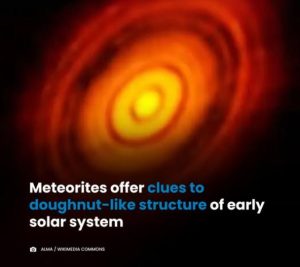
“Iron meteorites are hidden gems,” a researcher said, adding that they help us unravel the mysteries of our solar system.
The protoplanetary disk surrounding young star HL Tauri.
Roughly four billion years ago, our solar system formed out of a cloud of gas and dust swirling around the sun.
Scientists have long wondered about the structure of this protoplanetary disc, a planetary nursery, that formed our solar system.
While astronomers can observe distant protoplanetary disks, these come in many shapes and sizes, meaning it’s impossible to know exactly what ours looked like. That is, unless you were viewing it from billions of light years away.
Now, scientists believe meteorites might have some important clues about our solar system’s ancient past.
The shape of our early solar system
Meteorites formed during the early history of our solar system. It implies that these space rocks can tell us a great deal about the solar system’s inception.
In a new paper, published in Proceedings of the National Academy of Sciences, a team of planetary scientists from UCLA and Johns Hopkins University Applied Physics Laboratory explained that refractory metals in meteorites could provide clues about the structure of our early solar system.
Refractory metals, such as platinum and iridium, condense at high temperatures. According to the new paper, these were more abundant in meteorites formed in the outer disk, which was colder due to its distance from the sun. However, it’s believed that these metals should have formed close to the sun, suggesting some process moved them away from the inner disk.
According to the new paper, our solar disk likely didn’t have a ring structure at the beginning. Instead, it looked more like a doughnut. Asteroids with metal grains abundant in platinum and iridium would have migrated to the outer disk as this shape rapidly expanded.
Previous research using the Atacama Large Millimeter/submillimeter Array in Chile has led scientists to believe our protoplanetary disk was shaped in concentric rings, like a dartboard. This research identified many such protoplanetary disks around other stars.
These concentric rings wouldn’t allow refractory metals from the inner disk to travel to the outer disk. This is because the concentric rings are separated by gaps.
Using computer models, the team found that an expanding doughnut shape would have allowed these metals to reach the outer disk.

One question remained, however. After the disk expansion, why didn’t gravity pull these metals back into the sun?
“Once Jupiter formed, it very likely opened a physical gap that trapped the iridium and platinum metals in the outer disk and prevented them from falling into the sun,” first author Bidong Zhang, a UCLA planetary scientist, explained in a press statement.
Zhang concluded that iron meteorites are hidden gems, and the more we learn about them, the more they unravel the mystery of our solar system’s birth.


